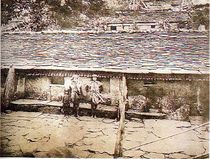
Paiwan people
From Wikipedia, the free encyclopedia
(Redirected from Paiwan)
The brick lower walls of this house show Chinese influence. The two
gables are covered with wooden boards, and the thatched roof is held
down with bamboo strips.
The interior of the house is divided into front and back rooms. The
sleeping platforms are located to the right of the entrance, and a food
preparation area is located to the left. The walls of the back room are
covered with rows of granaries. There are shelves above the hearth. Some
of the houses at Mudan Village are also seen to have stone slab walls
and stone pavement inside and outside the house in the book "An
Illustrated Account of the Taiwanese Aborigines." Further research will
be required to find out whether the materials used is this house are
different due to the tribe's migration.
The Paiwan (排灣) are an aboriginal tribe of Taiwan. They speak the Paiwan
language. In the year 2000 the Paiwan numbered 70,331. This was
approximately 17.7% of Taiwan's total indigenous population, making them
the third-largest tribal group.
 Slabstone House by Paiwan ca. Prior to 1945 |
The unique ceremonies in Paiwan are Masaru and Maleveq. The Masaru is a
ceremony that celebrates the harvest of rice, whereas the Maleveq
commemorates their ancestors or gods.
History
One of the most important figures in Paiwan history was supreme chief
Toketok (ca. 1817 - ca. 1873), who united 18 tribes of Paiwan under his
rule, and in 1867 concluded a formal agreement with Chinese and Western
leaders to ensure the safety of foreign ships landing on their coastal
territories in return for amnesty for Paiwan tribesmen who had killed a
ship's crew on a previous occasion.
Headhunting
The highland tribes were renowned for their skill in headhunting, which
was a symbol of bravery and valor (Hsu 1991:29–36). Almost every tribe
except the Yami (Tao) practiced headhunting. Once the victims had been
dispatched the heads were taken then boiled and left to dry, often
hanging from trees or shelves constructed for the purpose. A party
returning with a head was cause for celebration, as it would bring good
luck. The Bunun people would often take prisoners and inscribe prayers
or messages to their dead on arrows, then shoot their prisoner with the
hope their prayers would be carried to the dead. Han settlers were often
the victims of headhunting raids as they were considered by the
Aborigines to be liars and enemies. A headhunting raid would often
strike at workers in the fields, or employ the ruse of setting a
dwelling alight and then decapitating the inhabitants as they fled the
burning structure.


It was also customary to later raise the victim’s surviving children as full members of the tribe. Often the heads themselves were ceremonially ‘invited’ to join the tribe as members, where they were supposed to watch over the tribe and keep them safe. The indigenous inhabitants of Taiwan accepted the convention and practice of headhunting as one of the calculated risks of tribal life. The last groups to practice headhunting were the Paiwan, Bunun, and Atayal groups (Montgomery-McGovern 1922). Japanese rule ended the practice by 1930, but some elder Taiwanese can recall the practice (Yeh 2003).
Reference
http://en.wikipedia.org/wiki/Taiwanese_aborigines
http://en.wikipedia.org/wiki/Paiwan
http://www.flickr.com/photos/abohome/412316891/in/set-72157594572945211/